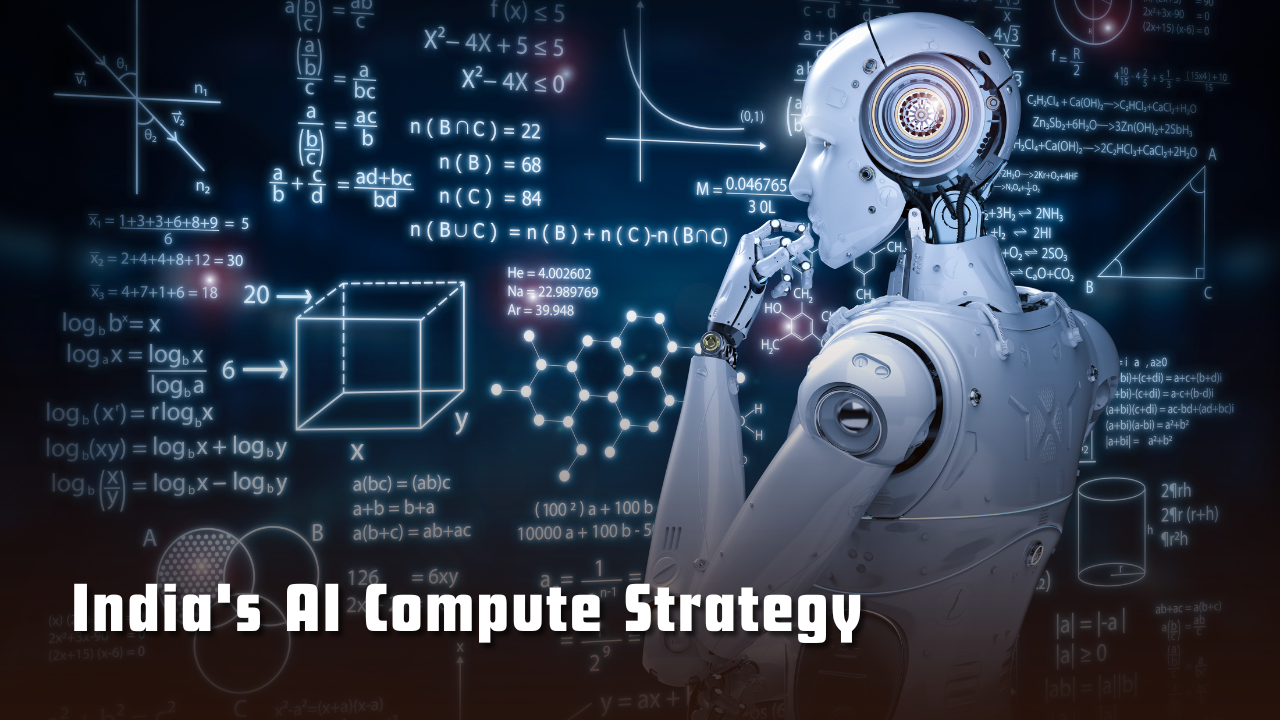Optimising Computing Approaches for India’s National AI Capabilities

Context: Artificial Intelligence (AI) has become a defining force in global technological advancement, with its growth underpinned by three key components—data, models, and compute. Of these, compute has emerged as the most scarce and strategically significant resource.
Exponential Growth in AI Compute Demand
- Since 2011, AI model training compute has increased by a factor of 350 million.
- Starting around 2010, deep learning’s rise caused AI compute requirements to double every 5.7 months.
- In 2015, large-scale ML models emerged, demanding 10 to 100 times more training compute than before.
- Unlike data and models, compute remains a scarce and critical resource for AI innovation.
Importance of National Compute Infrastructure
- A country’s national innovation capabilities in AI depend heavily on its compute infrastructure.
- Building foundational compute capabilities is vital for both economic development and national security.
- The unequal global distribution of compute resources makes national computing strategies imperative.
Increasing Demand for Data Centres and Resources
- According to McKinsey, global data centre capacity could triple by 2030, with 70% of this growth driven by AI.
- Data centres demand scarce resources like real estate and power; AI is projected to cause a 165% increase in data centre power demand by 2030.
- Advanced semiconductors and high-end technology inputs are essential to meet AI workload needs.
- Demand growth is also driven by cloud service providers catering to AI.
Necessity of Diverse Compute Approaches
- Given resource constraints and evolving needs, national compute strategies should include:
- Centralised data centres
- Distributed computing infrastructure, such as micro data centres and edge computing
- Edge computing (processing AI models near data sources or devices) is emerging as critical for sectors requiring low latency.
India’s Current Compute Landscape
- India’s data centre industry has grown robustly at a 24% CAGR since 2019.
- The IndiaAI Mission’s compute portal offers public access to GPUs at reduced rates; about 14,000 GPUs available, with plans to add more.
- Proposals exist for a decentralised network of micro data centres to optimise space, energy, and costs.
- The National Supercomputing Mission supports supercomputing for academic R&D.
- Innovations like IIT-Madras’ Kompact AI enable AI models to run on CPUs instead of GPUs, expanding compute accessibility.
- There is a strategic need to align these efforts with:
- The shift from training to inference workloads
- The rising role of edge computing
Global Approaches to Building AI Compute Infrastructure
- US: Market-led model with substantial private sector investments; home to large AI firms (OpenAI, AWS, Microsoft, Google) and chipmakers (NVIDIA, AMD, Intel).
- NVIDIA collaborates with hardware manufacturers (Foxconn, Dell, ASUS) to build AI-specialized data centres (“AI factories”).
- US policy supports domestic tech manufacturing and strategic AI infrastructure.
- China: State-led expansion of “intelligent computing centres” with private players like Alibaba, Tencent, and Baidu.
- Notable projects include an underwater data centre in Hainan for better energy efficiency and computational power.
- Rapid buildout led to oversupply and underutilised centres, often designed for training rather than inference.
- Shift to inference and low-latency reasoning models exposed mismatches in data centre locations, with central and rural sites less suited due to latency and proximity to tech hubs.
- European Union: Institutional, public-institutional framework via the European High-Performance Computing Joint Undertaking (EuroHPC).
- Focus on research hubs and enabling SMEs and start-ups.
- Targets strategic sectors like health, space, finance, climate, and manufacturing.
The Indian Imperative: Scale, Efficiency, and Access
- India’s approach is unique, balancing between:
-
-
- Government provisioning of GPUs under IndiaAI
- Rapid data centre growth
- Proposals for decentralised micro data centres
- Supercomputing for research
-
- Challenges include:
-
-
- Risk of market distortion due to government provisioning
- Bureaucratic hurdles that may limit access
- The shift in compute demand from training to inference and edge computing
-
- India must design policy to address:
-
- The evolving nature of compute demand (training vs inference, edge processing)
- Sectoral priorities with high AI adoption (telecommunications, manufacturing, automotive, healthcare)
- Innovation goals of the start-up ecosystem, especially in deep tech
- Ensuring low barriers to access for broad-based innovation and SME productivity
- Although inference demand is growing, India is simultaneously developing indigenous Large Language Models (LLMs) requiring significant training compute.
- Balancing compute capacity between training and inference is crucial.
Unlocking Innovation Potential Through Compute
- Most start-ups currently focus on application-driven innovation for faster returns.
- Deep tech’s rising importance demands understanding compute needs for broad innovation.
- Lowering access barriers will help drive AI adoption across sectors and geographies.
Strategic Recommendations for India’s Compute Policy
- Optimise computing strategies to balance:
- Scale (large data centres, AI factories)
- Efficiency (energy and resource optimisation, newer technologies)
- Access (public provisioning, decentralised micro data centres, edge computing)
- Harness market forces to promote private investment alongside government support.
- Encourage development of decentralised computing infrastructure complementing centralised resources.
- Align policy with geopolitical realities, economic factors, technological advances, and sectoral needs.
Subscribe to our Youtube Channel for more Valuable Content – TheStudyias
Download the App to Subscribe to our Courses – Thestudyias
The Source’s Authority and Ownership of the Article is Claimed By THE STUDY IAS BY MANIKANT SINGH

Leave a Reply